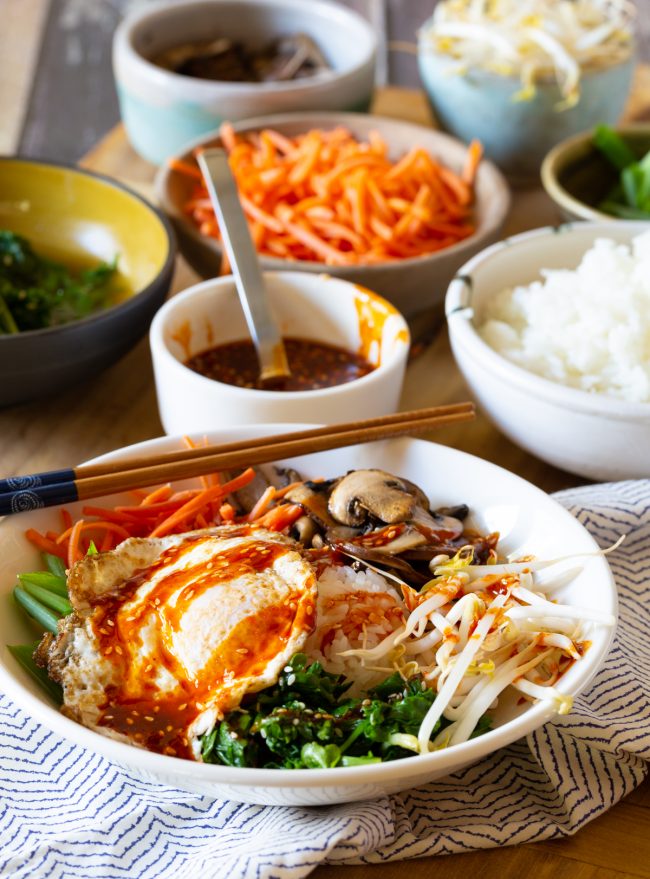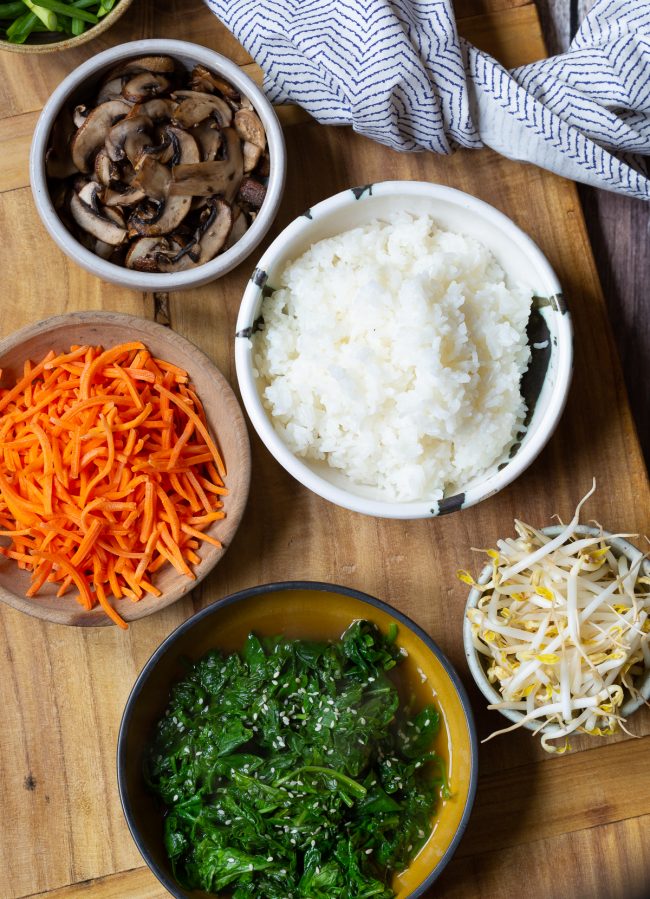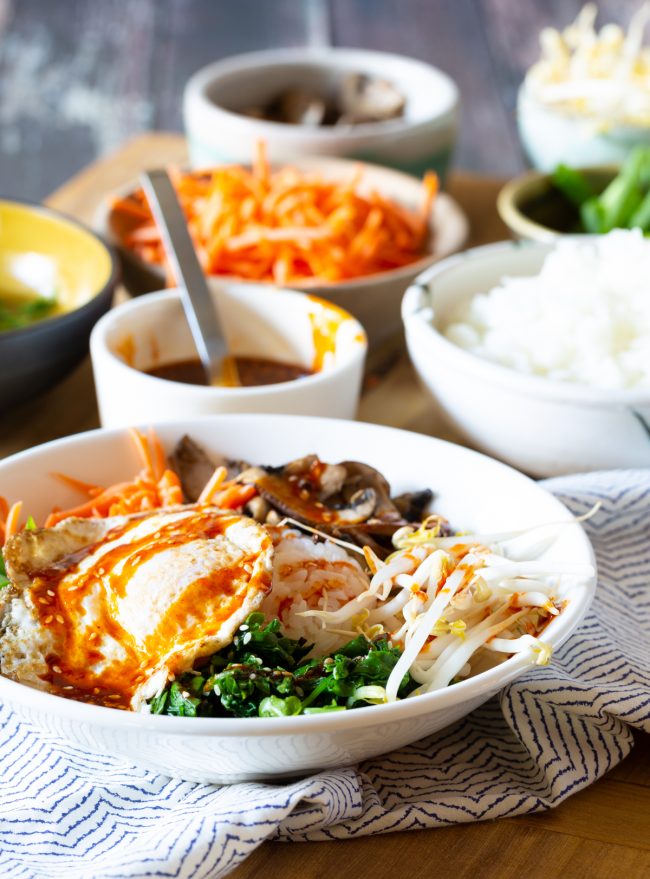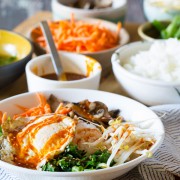Korean Bibimbap
Korean Bibimbap Recipe – Made with healthy veggies, a fried egg, and a homemade spicy-sweet Gochujang sauce, our easy Korean Bibimbap recipe is an exotic and comforting meal served in just one bowl.

What is Korean Bibimbap?
Don’t you just adore one-dish comfort foods? After a long day there’s nothing quite as wonderful as curling up with a big, warm bowl of deep savory flavors and satisfying textures.
Today I’m sharing a healthy and satisfying favorite, Korean Bibimbap.
This Korean specialty is an all-in-one meal that includes rice, raw veggies, sautéed veggies, a fried egg, and a sweet and spicy homemade Gochujang sauce over the top. Serve with kimchi on the side for even more tanginess!

What Ingredients You Need To Make Bibimbap
The key to making a great Korean Bibimbap bowl is to focus on fresh ingredients, perfectly runny eggs, and the homemade Gochujang sauce.
The vegetables can be adjusted to your liking, and this vegetarian dish can definitely be beefed up by adding Korean Bulgogi to each bowl.
Here’s what you need to make Korean Bibimbap:
- Cooked sticky rice – make fresh or use leftovers
- Veggies – loose leaf spinach (or kale), mushrooms, carrots, bean sprouts, and green onions… or whatever vegetables you prefer!
- Garlic – minced
- Sesame oil – for cooking
- Vegetable broth – helps to infuse great flavor into the leafy greens
- Sesame seeds – for lovely texture
- Eggs – fried easy to create a beautiful soft yolk
- Beef Bulgogi – or other cooked protein
Gochujang paste can be purchased at Asian markets, as well as stores like Whole Foods. However, for this recipe we’ve elevated the store-bought Gochujang by adding:
- Sesame oil
- Honey
- Rice vinegar
- Sesame seeds
This bright sticky-sweet sauce adds a bold punch of flavor to every bite of your Korean Bibimbap.

How to Make Easy Korean Bibimbap
- First, cook the rice according to package instructions. I recommend prepping your vegetables during this time.
- Once your veggies have all been sliced and chopped, place the spinach or kale in a pot with sesame oil, some of the vegetable broth, sesame seeds, and salt and pepper. Bring to a simmer and cook for a few minutes.
- Meanwhile, sauté sliced mushrooms and garlic in sesame oil over medium high heat in a large skillet. Once cooked and reduced, place aside in a bowl and cover to keep warm.
- Make your Gochujang sauce by whisking all of the ingredients together in a small bowl, and keep to the side until ready to serve.
- Next, wipe out the large skillet and fry the eggs in sesame oil while keeping the centers soft, about 1-2 minutes each side.
To serve, simply pile all of your prepared ingredients into one beautiful bowl. Start by placing warm rice at the bottom of the dish, layer fresh shredded carrots and bean sprouts with the cooked mushrooms and spinach, and top with beef bulgogi and fried eggs.
Allow each person to finish with a drizzle of the homemade Gochujang sauce and serve with kimchi on the side.
Get the Full (Printable) Korean Bibimbap Recipe Below. Enjoy!

Frequently Asked Questions
Can You Meal Prep Bibimbap?
You can prepare and refrigerate all of the individual ingredients a day or so before serving… Except for the fried eggs. Then simply reheat all of the components and fry eggs when ready to enjoy.
What Are Some Different Proteins I Can Use?
While I love classic bibimbap with Korean Bulgogi Beef, you can definitely swap out different proteins. Try adding cooked pork or chicken if you like!
Keep this a vegetarian dish by using cooked extra firm tofu; or skip extra protein all together and just top with fried eggs for an even easier meal.
Whether you serve Korean Bibimbap vegetarian style, or with beef, you are sure to love the robust flavors and healthy crunch in every bite!
How long do leftovers last in the fridge?
These leftovers will be fine in the fridge for 3 to 5 days as long as they are stored in an airtight container.
Can I freeze homemade bibimbap?
This recipe tastes the best when it is fresh, which makes this recipe unsuitable to be stored in the freezer.

Looking for more Asian-Inspired dishes?
- Vietnamese Bun Chu Gio Recipe
- Korean Beef Bulgogi Recipe
- Thai Nam Sod Salad Recipe
- Chinese Pot Stickers Recipe
- Classic Thai Fried Rice Recpe
- Thai Chicken Satay Reipe
- Vietnamese Banh Mi Sandwich Recipe
- Korean Pajeon Veggie Pancakes Recipe
- Thai Pad Ke Mao (Drunken Noodles) Recipe
- Chinese Hot Pots Recipe
Korean Bibimbap Recipe
Ingredients
For the Korean Bibimbap:
- 3 cups cooked sticky rice 1 1/4 cups dry rice
- 8 ounces loose leaf spinach or chopped kale
- 8 ounces sliced mushrooms oyster, shiitake, or cremini
- 1 cup shredded carrots
- 1 cup mung bean sprouts
- 1 bunch green onions cut into 1-inch segments
- 2 teaspoons sesame oil
- 1/4 cup vegetable broth
- 1 clove garlic minced
- 1 teaspoon sesame seeds
- 4 eggs
- Beef Bulgogi Recipe for non-vegetarian
- Salt and pepper
For the Gochujang Sauce:
- 1/2 cup Korean gochujang paste found at Asian markets or Whole Foods
- 2 tablespoons sesame oil
- 2 tablespoons honey
- 1 teaspoon rice vinegar
- 2 teaspoons sesame seeds
Instructions
- Cook the rice according to package instructions and set aside.
- Place the spinach in a pot and add 1 teaspoon sesame oil, 1/4 cup broth, and 1 teaspoon sesame seeds. Salt and pepper. Then cover and bring to a simmer. If wilted, remove from heat and keep covered. If not wilted, stir and cover again for 3-4 minutes.
- Place one teaspoon of sesame oil in a nonstick skillet over medium heat. Add the sliced mushrooms and garlic. Saute for approximately 10 minutes to cook and reduce. Salt and pepper to taste. Then place the mushrooms in a bowl and cover to keep warm.
- In a small bowl, mix the ingredients for the gochujang sauce and set aside.
- Wipe out the skillet, then place back over medium heat. Fry 4 eggs (maybe 2 at a time) on both sides keeping the centers soft, 1-2 minutes per side.
- When ready to serve, place a heap of warm rice in four bowls. Arrange the wilted spinach, sautéed mushrooms, shredded carrots, bean sprouts and green onions around the rice. (If adding the Beef Bulgogi to the Bibimbap, arrange around the rice as well.) Then top with a hot fried egg and drizzle with gochujang sauce. Serve warm!



I saw Bibimbap many times in Korean drama, gonna try this dish soon! Thank you for sharing the recipe!
Hello. I have a quick question: I have gochijang paste-is that different from the sauce? And if so, is it possible to use it as a substitute? Thanks!
Hi Jess, I think it’s the same. Is it really really thick, or about the consistency of thick BBQ sauce?
Looks delicious! I love making asian dishes at home and will have to try this out soon.
We’re big bibimbap fans. Eric and I actually went out for some yesterday at a local Korean market. Will definitely need to try making it at home!
I love bibimbap! The variety of toppings and gochujang sauce are the best!
So much goodness in one bowl, YUM!
I absolutely love Korean Bibimbap. This looks so amazing!
Looks delicious—I love Asian influenced food—-except for the egg. I am one of those people who don’t like frazzle on their egg. However I have found out lots of people do. Love the diversity of the world!
Your photos are gorgeous, per usual! I’ve never had Korean food, but that sauce looks outstanding :)
GAHHH!!!! This looks SO good to me!!!!